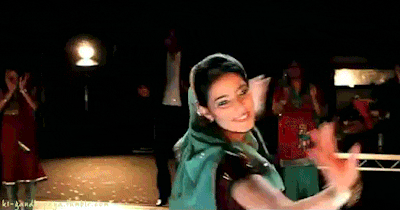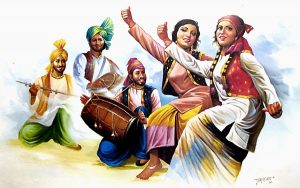Previously, I made mention to the complexities that create bhangra. Bhangra has become known as one, major popular dance form, but it stands for more than one dance. It is an amalgamation of numerous styles that each have their own story of development. Different regions of Punjab had their own unique interpretations of the songs and dances, and as a result, there were different styles and moves created in each region. After time, people began to get together and celebrate the bigger events and holidays. They shared their stories of bhangra, and they taught each other their own moves. There was a community being formed through the dance. Examples of the different styles that I will discuss include Sammi and Jhummar. There are many more styles involved, but the two I will mention today are among the popular styles that hold the greatest story in terms of its history.
Sammi is a traditional part of bhangra that is traditionally performed by women. It originated in West Punjab, and women would gather and perform Sammi at personal, joyous moments such as weddings and child births. The style was rumored to have vanished from bhangra due to historical tensions between India and Pakistan. However, in the 90s and early 2000s as the dance became more international, Sammi was brought back into the light. The original, folk manner of dancing consists of a girl singing in the middle of a circle as dancers around her sway along with the beat. The lyrics of the songs revolve around the theme of love and romance, and this is then translated into the dance as well with the swaying. However, swaying in this context does not mean a light side-to-side motion. The dancers would move their legs in a hopping manner, and at the same time their arms would wave around their body. The unique identity of this dance is the circular manner of movement, and it’s also iconic how the arms swing across the body in clapping manner. The key element and significance of this is the unity of the body movements with the melody of the music.

Jhummar is another very traditional move, but this is associated historically with masculinity. Men would perform this style as an expression of their happiness. The exact choreography is very similar to that of Sammi. There is swaying involved with this too, but it is not as energetic. There is not much hopping involved, and the arms don’t move across the body either. In this style, dancers form a circle around a drummer, and they move around in a circular motion. The actual choreography involves the legs moving forward and backward. One foot at a time, dancers extend their foot out diagonally and switch between the two. The arms would often remain above the head and the wrists would flick with the beat of the drum. Sometimes, only one arm would remain above the head, and the other would rest on the hip. Then, the dancers would switch arms after every beat or two. This is personally my favorite style because of the elegance it has in the moves, and when coordinated with all dancers, it can look very powerful!

Again, these are only two of many styles that make the whole dance of bhangra. They are elegantly choreographed moves, and they hold great significance to the dance as well. Another significant point of bhangra is the clothing worn by the dancers. From the pictures I post, you may have noticed the colorful elements as well as the accessories on the clothes. Next week, I will discuss in further detail what each of the elements are and a little on their history too.



